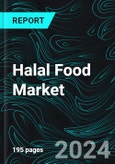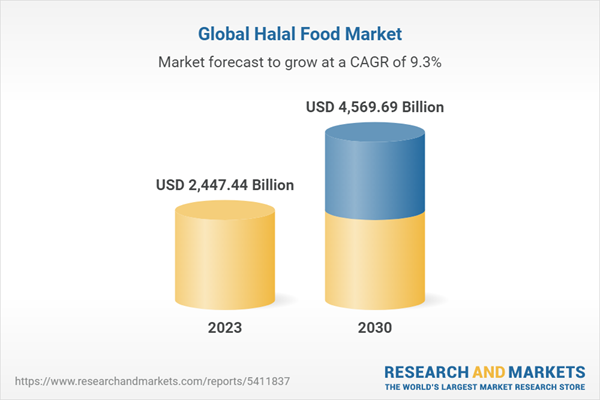Global Halal Food Market is anticipated to increase at a CAGR of 9.33% in the forecast period (2024 to 2030)
The increasing Muslim populace globally is significantly contributing to the marketplace's increase. Muslims are expected to incorporate over one-fourth of the global populace. With the expanded need, producers have increased their product portfolio by imparting numerous value-added halal food items, like pasta, vegetables, juice, milk, yogurt, and cheese. Further, sizeable corporations' production of halal-certified meals will boost product visibility among purchasers.Moreover, various Islamic and non-Islamic countries are applying strict regulatory structures, which involve globally accepted standards, to attract new participants in the market. Recently, the Saudi Arabia Food and Drug Authority (SFDA) prolonged the mandatory requirement of halal certification from imported meat and meat-based goods to all imported sweets, long-service life products, frozen and chilled goods, milk and dairy products, and fats and oils. With the increased demand for halal foods, manufacturers have extended their portfolio by establishing numerous value-added food commodities, including sandwiches, cookies, hot dogs, soups, candies, burgers, creams, and pizzas. Thus, increasing the implementation of strict rules regarding halal foods is likely to propel market growth. Hence, the global halal food market was US$ 2,447.44 Billion in 2023.
Islam is the fastest-expanding religion, mainly in Asia Pacific, which will positively impact the demand for halal products in the area. As per an article published in China Highlights, in February 2022, about 25 million Muslims are living across China, and they are further strengthened in small groups, with Islam being the central community. The increasing awareness among Muslims regarding the necessity of consuming non-haram food because of their religious sentiments is expected to drive the market.
Meat products are estimated to have the majority share in the halal food market
By product, the global halal food market is fragmented into Meat, Poultry & Seafood, Fruits & Vegetables, Dairy Products, Cereals & Grains, Oil, Fats & Waxes, Confectionery, and Others. The meat phase is predicted to dominate the halal food industry. This is due to the increasing demand for microorganism-free meat, pushed via fitness, hygiene, and protection worries. In addition, there is a growing awareness and consideration for animal welfare and diversity, key elements driving an increase in this section.Hypermarkets and supermarkets are major distribution channels in the halal food market
By distribution channel, the global halal food market is categorized into Hypermarkets & supermarkets, Online Stores, Convenience Stores, Specialty Stores, and Others. Supermarkets and hypermarkets have contributed to most of the halal food market percentage. The main driving forces are the growing presence and choice of supermarkets and hypermarkets. As the global inflation rate rises, purchasers decide to shop from supermarkets, given that they can access a wider variety of options and other economic blessings, discounted charges, incentives, and a couple of offers on more recent merchandise. Moreover, several new groups launch their products in supermarkets due to a higher customer footfall, which translates to better advertising and marketing or advertising value performance.The Muslim population in India has significant potential for growth in the halal food market
By countries, the global halal food market is comprised of Pakistan, Indonesia, India, Bangladesh, Nigeria, Egypt, Turkey, Iran, China, Algeria, Iraq, Morocco, Saudi Arabia, Malaysia, Russia, Kazakhstan, United Arab Emirates, France, Germany, United States, Italy, United Kingdom, Canada, Qatar, and Rest of the World. The market for halal food in India is expected to experience huge growth. This is due to the migration of humans from Muslim-ruled areas to different areas, which has contributed to a giant boom in the Muslim populace inside India. As the range of Muslims maintains to rise, so too does the demand for halal food, with this fashion predicted to remain in the foreseeable future. The hastily growing Muslim populace, coupled with their increasing purchasing power, is anticipated to drive a similar boom within the halal grocery store for the duration of the forecast period.Key Players
The halal food market is comprised of companies like Nestle SA, JBS SA, BRF SA, Kawan Food Berhad, Cargill Inc., Carrefour SA, Crescent Foods Inc., VegaVites, American Halal Company Inc., American Foods Group LLC, and Al Islami Foods.In August 2023 - Al Islami Foods Co. re-launched its premium Chicken Griller and Chicken Parts in Qatar, offering a variety of cuts. The brand is committed to the highest Halal standards.
In February 2023 - Chicken Cottage, a UK-based fast food chain with halal options, partnered with Express Kitchen to expand in East Africa.
The report titled “Global Halal Food Market By Product (Meat, Poultry & Seafood, Fruits & Vegetables, Dairy Products, Cereals & Grains, Oil, Fats & Waxes, Confectionery, and Others), Distribution Channel (Hypermarkets & Supermarkets, Online Stores, Convenience Stores, Specialty Stores, and Others), Countries (Pakistan, Indonesia, India, Bangladesh, Nigeria, Egypt, Turkey, Iran, China, Algeria, Iraq, Morocco, Saudi Arabia, Malaysia, Russia, Kazakhstan, United Arab Emirates, France, Germany, United States, Italy, United Kingdom, Canada, Qatar, and Rest of the World), Company Analysis (Nestle SA, JBS SA, BRF SA, Kawan Food Berhad, Cargill Inc., Carrefour SA, Crescent Foods Inc., VegaVites, American Halal Company Inc., American Foods Group LLC, and Al Islami Foods)” provides a complete study of the Global Halal Industry.
Product - Global Halal Food Market breakup in 9 viewpoints:
1. Meat2. Poultry & Seafood
3. Fruits & Vegetables
4. Dairy Products
5. Cereals & Grains
6. Oil
7. Fats & Waxes
8. Confectionery
9. Others
Distribution Channel - Global Halal Food Market breakup in 5 viewpoints:
1. Hypermarkets & Supermarkets2. Online Stores
3. Convenience Stores
4. Specialty Stores
5. Others
Countries - Global Halal Food Market breakup in 25 viewpoints:
1. North America1.1 United States
1.2 Canada
2. Europe
2.1 Russia
2.2 France
2.3 Germany
2.4 Italy
2.5 United Kingdom
2.6 Turkey
3. Asia
3.1 Pakistan
3.2 Indonesia
3.3 India
3.4 Bangladesh
3.5 China
3.6 Malaysia
3.7 Kazakhstan
4. Middle East & Africa
4.1 Saudi Arabia
4.2 United Arab Emirates
4.3 Qatar
4.4 Iraq
4.5 Iran
4.6 Egypt
4.7 Algeria
4.8 Morocco
4.9 Nigeria
5. Rest of the World
All the Key players have been covered from 3 Viewpoints:
- Overview
- Recent Development
- Revenue Analysis
Company Analysis:
1. Nestle SA2. JBS SA
3. BRF SA
4. Kawan Food Berhad
5. Cargill Inc.
6. Carrefour SA
7. Crescent Foods Inc.
8. VegaVites
9. American Halal Company Inc.
10. American Foods Group LLC,
11. Al Islami Foods
Table of Contents
Companies Mentioned
- Nestle SA
- JBS SA
- BRF SA
- Kawan Food Berhad
- Cargill Inc.
- Carrefour SA
- Crescent Foods Inc.
- VegaVites
- American Halal Company Inc.
- American Foods Group LLC,
- Al Islami Foods
Methodology
In this report, for analyzing the future trends for the studied market during the forecast period, the publisher has incorporated rigorous statistical and econometric methods, further scrutinized by secondary, primary sources and by in-house experts, supported through their extensive data intelligence repository. The market is studied holistically from both demand and supply-side perspectives. This is carried out to analyze both end-user and producer behavior patterns, in the review period, which affects price, demand and consumption trends. As the study demands to analyze the long-term nature of the market, the identification of factors influencing the market is based on the fundamentality of the study market.
Through secondary and primary researches, which largely include interviews with industry participants, reliable statistics, and regional intelligence, are identified and are transformed to quantitative data through data extraction, and further applied for inferential purposes. The publisher's in-house industry experts play an instrumental role in designing analytic tools and models, tailored to the requirements of a particular industry segment. These analytical tools and models sanitize the data & statistics and enhance the accuracy of their recommendations and advice.
Primary Research
The primary purpose of this phase is to extract qualitative information regarding the market from the key industry leaders. The primary research efforts include reaching out to participants through mail, tele-conversations, referrals, professional networks, and face-to-face interactions. The publisher also established professional corporate relations with various companies that allow us greater flexibility for reaching out to industry participants and commentators for interviews and discussions, fulfilling the following functions:
- Validates and improves the data quality and strengthens research proceeds
- Further develop the analyst team’s market understanding and expertise
- Supplies authentic information about market size, share, growth, and forecast
The researcher's primary research interview and discussion panels are typically composed of the most experienced industry members. These participants include, however, are not limited to:
- Chief executives and VPs of leading corporations specific to the industry
- Product and sales managers or country heads; channel partners and top level distributors; banking, investment, and valuation experts
- Key opinion leaders (KOLs)
Secondary Research
The publisher refers to a broad array of industry sources for their secondary research, which typically includes, however, is not limited to:
- Company SEC filings, annual reports, company websites, broker & financial reports, and investor presentations for competitive scenario and shape of the industry
- Patent and regulatory databases for understanding of technical & legal developments
- Scientific and technical writings for product information and related preemptions
- Regional government and statistical databases for macro analysis
- Authentic new articles, webcasts, and other related releases for market evaluation
- Internal and external proprietary databases, key market indicators, and relevant press releases for market estimates and forecasts

LOADING...
Table Information
| Report Attribute | Details |
|---|---|
| No. of Pages | 195 |
| Published | February 2024 |
| Forecast Period | 2023 - 2030 |
| Estimated Market Value ( USD | $ 2447.44 Billion |
| Forecasted Market Value ( USD | $ 4569.69 Billion |
| Compound Annual Growth Rate | 9.3% |
| Regions Covered | Global |
| No. of Companies Mentioned | 11 |









